Spatial Layout and Coupling of Urban Cultural Relics: Analyzing Historical Sites and Commercial Facilities in District III of Shaoxing
Abstract
1. Introduction
2. Literature Review
2.1. General Research on Commercial Facilities and CRHSs
2.2. Relevant Quantitative Research on Commercial Facilities
2.3. Methodology Used in Current Research on Spatial Distribution and Coupling Analysis
2.4. Ways of Analyzing Accessibility of Commercial Facilities
2.5. Related Research on Spatial Policy About CRHSs
3. Methodology
3.1. Study Areas and Data
3.2. Methods
3.2.1. Kernel Density Estimation
3.2.2. Standard Deviational Ellipse
3.2.3. Network Analysis
3.2.4. Inverse Distance Weight
3.2.5. Spatial Correlation Analysis
3.3. Research Route
4. Results
4.1. Spatial Distribution Characteristics of CHRS and Commercial Facilities
4.2. Spatial Correlation Analysis between CHRS, Commercial Facilities and Road Network
4.3. Distribution of Commercial Facilities in Different Isochronous Circles of CHRSs
- (1)
- There are remarkable differences in the number of commercial facilities around different CRHSs. Nearly 50 percent of CRHSs do not have commercial facilities around them, whereas a large number of commercial facilities exist around some CRHSs. According to the classification of CRHSs, this phenomenon is closely related to the level of protection of CRHSs. More than 80% of the national key and provincial CRHSs protection units have more than 10 commercial facilities around them. There are no commercial facilities around them, mainly municipal cultural relic protection units, which are mainly distributed in non-central areas of each region;
- (2)
- There is little difference in distributing the same commercial facility within different isochronous circles of cultural relics and monuments. It can be seen from Figure 6 that within the isochronous ranges of 5 min, 10 min, and 15 min of CRHSs, the number distribution of commercial facilities is relatively balanced, and there is no obvious quantity distribution law. This shows that the distribution centers of commercial facilities are often not consistent with the distribution centers of CRHSs, and the distribution of commercial facilities is more affected by the selection of location and market rules;
- (3)
- In the commercial facilities around the CRHSs, Retail and Catering accounted for more than Entertainment. Among the CRHSs surrounding more than 10 commercial facilities, the number of Catering and Retail is similar but much higher than Entertainment. Among the CRHSs without commercial facilities, Entertainment accounts for the largest proportion. This is closely related to the characteristics of each commercial facility and public demand.
4.4. Accessibility Analysis of CRHSs to Commercial Facilities
5. Discussion
- (1)
- CRHSs and commercial facilities show an unbalanced distribution in spatial layout. The overall distribution of commercial facilities shows patchy aggregation, which is affected by traffic and commercial location selection. The distribution of different categories of commercial facilities is also unbalanced. The degree of agglomeration, distribution trend, center position, and correlation with road networks of different formats reflects degrees of difference, closely related to the characteristics of various formats and market rules. A previous study found that traffic and commercial spatial arrangement is vital for maximizing economic advantages and improving transportation systems. Conducting the spatial distribution analysis, location analysis, and correlation analysis between retail space and its street, the closeness density was used, and the results showed varying levels of correlation by commercial cluster; the closer a route is to its center, the shorter its average distance to other roads, and the greater its accessibility [63,64]. Furthermore, physical accessibility is a crucial factor for the location strategy of commercial facilities. In a case study of Bologna [24], Barcelona [65], and Changchun [66] conducted correlation analysis using network structures, and also indicated that the commercial facilities tend to be concentrated with better density and closeness to the road network. In this study, the centers of CRHSs were clustered significantly, which was closely related to the city’s origin. The previous research of Huai’an city’s historical sites in China indicates that many of the chosen historical sites are situated close to each other; they are all located in the old city. The surrounding areas involving commercial facilities are also located close to the historical sites [67]. In the follow-up study, we can strengthen the research on the characteristics of different commercial facilities and the correlation between urban origin and the distribution of CRHSs;
- (2)
- CRHSs and commercial facilities are positively correlated with road network density. The layout characteristics of commercial facilities along the main road of the city are apparent. For many CRHSs in areas with low accessibility of commercial facilities, improving road network density and traffic system is often more effective than increasing the number of facilities. Previous studies have investigated the impact of road network density on commercial spaces in general. Hossain [68] studied retail growth in Dhaka and found that the topology of the road network, particularly accessibility and connectedness, plays a crucial role in commercial development, in which the aggregation of commercial with easy access has progressively become a trend. Furthermore, in their study of street centrality and land-use intensity in Louisiana, Wang et al. [69] found that road network density is critical in reflecting the city’s favorable position and defining the concentration of commercial land use inside the city. According to this research, areas with poor accessibility are generally distributed in the suburbs of the city, such as Shangpu Town, Xiaguan Town, Tangpu Town, etc. The reason for this phenomenon is not only the small number of facilities, but also the low density of the road network. CRHSs are crucial elements of a city that create a stimulating and economically attractive environment [70]. CRHS accessibility contributes to economic success when the place can be visited and explored in a timely, cost-effective, and comfortable manner [71]. Therefore, it is necessary to strengthen the construction of urban roads in these areas, increase the density of branches, improve road conditions, open T-shaped roads and broken roads, and increase the accessibility of road networks, to make public travel smoother, which can also effectively improve the accessibility of CRHSs;
- (3)
- The accessibility from CRHSs to commercial facilities is closely related to the level of cultural relic protection. This shows that the higher the level of cultural relic protection, i.e., the higher its protection value, the more likely it is that its corresponding facilities are complete, and the attraction to tourists will be stronger. As a tool for sustainable tourism development and place branding, CRHSs make a region more attractive to visitors; hence, they may be a driving instrument to promote cities and areas. The reviving project of CRHSs in many areas in Russia showed that the completeness of corresponding amenities that meet tourist demands is an enticing element of unique CRHSs that can attract visitors [72]. At the same time, this study indicated CRHSs with high protection level. However, low commercial accessibility was identified, their characteristics and geographical location were analyzed in detail, and corresponding countermeasures were put forward according to local conditions;
- (4)
- A large number of CRHSs gather to form a commercial agglomeration effect, which becomes the highest coupling area. The central street of Yuecheng District is the area with the largest density of CRHSs and the largest number of historical and cultural blocks. It is also the area with the best accessibility of CRHSs to commercial facilities. According to a study of the southern historical district in Nanjing, China, the accessibility from CRHSs to commercial facilities has become one of the primary drivers of local economic growth by boosting the tourism industry and the prosperity of commercial facilities [73]. With the implementation of the action plan for improving the environment of ancient cities in Yuecheng District, further improving the environment and commercial facilities of ancient cities in the main urban area will further expand this agglomeration effect.
6. Conclusions
- (1)
- From the point of view of spatial layout, there is a positive correlation between CRHSs and commercial facilities. Among them, the distribution of CRHSs has the strongest correlation with the distribution of road networks. Among different categories of commercial facilities, CRHSs have the strongest correlation with Entertainment, indicating that the spatial distribution here is the highest;
- (2)
- There are significant differences in the number of commercial facilities around different CRHSs. This is closely related to the protection level of cultural relic sites, and the commercial facilities around national key and provincial cultural relic protection units are much larger than those around municipal cultural relic protection units;
- (3)
- The accessibility levels of commercial facilities in CRHSs are significantly different. The overall pattern shows a distribution trend of high in the middle and low on both sides. The accessibility of CRHSs to commercial facilities is consistent with their single-center spatial layout, and the accessibility level of non-central regions is significantly low. This is positively correlated with the layout characteristics of CRHSs and the density distribution of road networks;
- (4)
- The distribution of good and comparatively bad accessibility areas from CRHSs to commercial facilities in different administrative regions is extremely uneven. The area with better accessibility value and worse accessibility value shows that a large number of CRHSs are highly coincident with commercial aggregation points, and they form a good coupling relationship. On the contrary, it shows that the coupling relationship is not good.
Author Contributions
Funding
Institutional Review Board Statement
Informed Consent Statement
Conflicts of Interest
References
- Gong, X. The Protection of the Cultural Relics and Historic Sites and Its Tourism Exploitation. Areal Res. Dev. 2009, 6, 110–113. [Google Scholar]
- Xing, H.; Marzuki, A.; Razak, A.A. Protective Development of Cultural Heritage Tourism the Case of Lijiang, China. Theor. Empir. Res. Urban Manag. 2012, 7, 39–54. [Google Scholar]
- Dichen, G.; Guangrui, Z. China’s tourism: Policy and practice. Tour. Manag. 1983, 4, 75–84. [Google Scholar] [CrossRef]
- Jucu, I.; Voiculescu, S. Abandoned Places and Urban Marginalized Sites in Lugoj Municipality, Three Decades after Romania’s State-Socialist Collapse. Sustainability 2020, 12, 7627. [Google Scholar] [CrossRef]
- Díaz-Andreu, M. Heritage Values and the Public. J. Community Archaeol. Herit. 2017, 4, 2–6. [Google Scholar] [CrossRef]
- Timothy, D.J. Contemporary Cultural Heritage and Tourism: Development Issues and Emerging Trends. Public Archaeol. 2014, 13, 30–47. [Google Scholar] [CrossRef]
- Laing, J. Sustainable marketing of cultural and heritage tourism. J. Heritage Tour. 2011, 6, 173–174. [Google Scholar] [CrossRef]
- Britton, S. Tourism, Capital, and Place: Towards a Critical Geography of Tourism. Environ. Plan. D Soc. Space 1991, 9, 451–478. [Google Scholar] [CrossRef]
- Sebastian, J. The spatial polarization of small-sized towns in Timiş County of Romania. In Proceedings of the 15th International Multidisciplinary Scientific GeoConference SGEM 2015 Conference Proceedings, Albena, Bulgaria, 18–24 June 2015; Issue 3. pp. 729–736. [Google Scholar] [CrossRef]
- Jucu, I.S. Recent Issues of Spatial Restructuring in Romanian Medium-Sized Towns: Spatial Conversion and Local Urban Regeneration; Surveying Geology & Mining Ecology Management (SGEM): Sofia, Bulgaria, 2016; Volume 3, pp. 493–500. [Google Scholar] [CrossRef]
- Zhao, Y.; Wang, S.; Ge, Y.; Liu, Q.; Liu, X. The spatial differentiation of the coupling relationship between urbanization and the eco-environment in countries globally: A comprehensive assessment. Ecol. Model. 2017, 360, 313–327. [Google Scholar] [CrossRef]
- A Study on the Spatial Coupling Relationship between Urban Complex and Public Transportation Based on Vitality Orientation—The Comparison of the International Finance Center between Shanghai and Hongkong. Available online: http://www.uia2017seoul.org/P/papers/Full_paper/Paper/Poster/P-0402.pdf (accessed on 3 May 2021).
- Wu, Y.; Zhu, X.; Gao, W.; Qian, F. The spatial characteristics of coupling relationship between urbanization and eco-environment in the Pan Yangtze River Delta. Energy Procedia 2018, 152, 1121–1126. [Google Scholar] [CrossRef]
- Zhou, K.; Peng, X.; Guo, Z. Evaluation Method of Coupling between Urban Spatial Structure and Public Transport System. In Proceedings of the 2019 5th International Conference on Transportation Information and Safety (ICTIS), Liverpool, UK, 14–17 July 2019; pp. 723–729. [Google Scholar] [CrossRef]
- Liu, S.-G.; Shang, Y.-S.; Liu, C.-Y. Spatial-temporal Coupling and Coordinating between Urbanization and Tourism Development: A Case Study of Zhoushan Archipelago, China. In Proceedings of the 2019 International Conference on Modeling, Analysis, Simulation Technologies and Applications (MASTA 2019), Hangzhou, China, 26–27 May 2019; Volume 168, pp. 111–118. [Google Scholar] [CrossRef]
- Ma, F.; Ren, F.; Yuen, K.F.; Guo, Y.; Zhao, C.; Guo, D. The spatial coupling effect between urban public transport and commercial complexes: A network centrality perspective. Sustain. Cities Soc. 2019, 50, 101645. [Google Scholar] [CrossRef]
- Liang, X.; Li, Y. Identification of spatial coupling between cultivated land functional transformation and settlements in Three Gorges Reservoir Area, China. Habitat Int. 2020, 104, 102236. [Google Scholar] [CrossRef]
- Xia, X.; Lin, K.; Ding, Y.; Dong, X.; Sun, H.; Hu, B. Research on the Coupling Coordination Relationships between Urban Function Mixing Degree and Urbanization Development Level Based on Information Entropy. Int. J. Environ. Res. Public Heal. 2020, 18, 242. [Google Scholar] [CrossRef]
- Rae, A.; Murdock, V.; Popescu, A.; Bouchard, H. Mining the web for points of interest. In Proceedings of the 35th International ACM SIGIR Conference on Research and Development in Information Retrieval, Portland, OR, USA, 12–16 August 2012. [Google Scholar] [CrossRef]
- Hansen, W.G. How Accessibility Shapes Land Use. J. Am. Inst. Planners 1959, 25, 73–76. [Google Scholar] [CrossRef]
- Zhang, X.N.; Shi, M.H. Discussion on the modes of spatial layout in China’s urban community business. J. Beijing Technol. Bus. Univ. 2009, 24, 28–33. [Google Scholar]
- Niu, Q.; Qu, H.; Niu, X.; Zhao, J.; Li, Z.; Zhou, J. The Impact of Spatial Distribution of Commercial Facilities in Communities on Residents’ Walking-Based Consumption Behavior: A Case Study in Wuhan, China. Sustainability 2018, 10, 3601. [Google Scholar] [CrossRef]
- Yi, X. A Study on Community Retail and Service Facilities Based on Consumption Theories—The Case of Shanghai. Urban Plan. Forum 2012, 65, 44–52. [Google Scholar]
- Porta, S.; Strano, E.; Iacoviello, V.; Messora, R.; Latora, V.; Cardillo, A.; Wang, F.; Scellato, S. Street Centrality and Densities of Retail and Services in Bologna, Italy. Environ. Plan. B Plan. Des. 2009, 36, 450–465. [Google Scholar] [CrossRef]
- Wang, J. Problems and solutions in the protection of historical urban areas. Front. Arch. Res. 2012, 1, 40–43. [Google Scholar] [CrossRef]
- Chai, R.; Li, H. A Study on Legislation for Protection of Cultural Relics in China: Origin, Content and Model. Chin. Stud. 2019, 8, 132–147. [Google Scholar] [CrossRef]
- Rogerson, C.M. The uneven geography of business tourism in South Africa. S. Afr. Geogr. J. 2015, 97, 183–202. [Google Scholar] [CrossRef]
- Poulaki, I.; Papatheodorou, A.; Panagiotopoulos, A.; Liasidou, S. Exclave accessibility and cross-border travel: The pene-exclave of Ceuta, Spain. Tour. Geogr. 2020, 87, 1–25. [Google Scholar] [CrossRef]
- Rátz, T.; Smith, M.; Michalkó, G. New Places in Old Spaces: Mapping Tourism and Regeneration in Budapest. Tour. Geogr. 2008, 10, 429–451. [Google Scholar] [CrossRef]
- Hua, Q.; Guo, Y. Research of Informational System for the Historical Relics Protection of Three Gorgies Reservior Region Based on RS & GIS. Areal Res. Dev. 2004, 40, 118–122. [Google Scholar]
- Wang, T.; Wang, Y.; Zhao, X.; Fu, X. Spatial distribution pattern of the customer count and satisfaction of commercial facilities based on social network review data in Beijing, China. Comput. Environ. Urban Syst. 2018, 71, 88–97. [Google Scholar] [CrossRef]
- Okabe, A.; Satoh, T.; Sugihara, K. A kernel density estimation method for networks, its computational method and a GIS-based tool. Int. J. Geogr. Inf. Sci. 2009, 23, 7–32. [Google Scholar] [CrossRef]
- McKenzie, G.; Janowicz, K.; Gao, S.; Gong, L. How where is when? On the regional variability and resolution of geosocial temporal signatures for points of interest. Comput. Environ. Urban Syst. 2015, 54, 336–346. [Google Scholar] [CrossRef]
- Fu, Y.; Shan, X. Study on the distribution density of commercial facilities in the main urban area of shenyang based on POI data. In Proceedings of the Chinese Control and Decision Conference (CCDC), Shenyang, China, 9–11 June 2018; pp. 3046–3050. [Google Scholar] [CrossRef]
- Li, Q.; Zhang, T.; Wang, H.; Zeng, Z. Dynamic accessibility mapping using floating car data: A network-constrained density estimation approach. J. Transp. Geogr. 2011, 19, 379–393. [Google Scholar] [CrossRef]
- Borruso, G. Network Density Estimation: A GIS Approach for Analysing Point Patterns in a Network Space. Trans. GIS 2008, 12, 377–402. [Google Scholar] [CrossRef]
- Roig-Tierno, N.; Baviera-Puig, A.; Buitrago-Vera, J.; Mas-Verdú, F. The retail site location decision process using GIS and the analytical hierarchy process. Appl. Geogr. 2013, 40, 191–198. [Google Scholar] [CrossRef]
- Mendes, A.B.; Themido, I.H. Multi-outlet retail site location assessment. Int. Trans. Oper. Res. 2004, 11, 1–18. [Google Scholar] [CrossRef]
- Miller, H.J. Modelling accessibility using space-time prism concepts within geographical information systems. Int. J. Geogr. Inf. Syst. 1991, 5, 287–301. [Google Scholar] [CrossRef]
- O’Sullivan, D.; Morrison, A.M.; Shearer, J. Using desktop GIS for the investigation of accessibility by public transport: An isochrone approach. Int. J. Geogr. Inf. Sci. 2000, 14, 85–104. [Google Scholar] [CrossRef]
- Yang, Y.; Wong, K.K.F. Spatial Distribution of Tourist Flows to China’s Cities. Tour. Geogr. 2013, 15, 338–363. [Google Scholar] [CrossRef]
- Wachs, M.; Kumagai, T. Physical accessibility as a social indicator. Socio-Econ. Plan. Sci. 1973, 7, 437–456. [Google Scholar] [CrossRef]
- Santos, F.; Almeida, A.; Martins, C.; Gonçalves, R.; Martins, J. Using POI functionality and accessibility levels for delivering personalized tourism recommendations. Comput. Environ. Urban Syst. 2019, 77, 101–173. [Google Scholar] [CrossRef]
- Peffers, K.; Tuunanen, T.; Rothenberger, M.A.; Chatterjee, S. A Design Science Research Methodology for Information Systems Research. J. Manag. Inf. Syst. 2007, 24, 45–77. [Google Scholar] [CrossRef]
- Zhang, X. Research on Resource Management System of Natural and Cultural Heritage. In Strengthening Regulation: Protection, Management and Utilization of Natural and Cultural Heritage in China, Beijing; Social Sciences Academic Press: Beijing, China, 2006; pp. 55–57. [Google Scholar]
- State Council of China. The State Council on Further Improving the Protection of Cultural Relics in Tourism and Other Development and Construction Activities. Available online: http://www.gov.cn/zhengce/content/2012-12/26/content_3935.htm (accessed on 3 May 2021).
- Huang, J.; Zhang, T.X.; Takayoshi, Y. Study on tourism commerce population and spatial distribution in old town of Lijiang. Chin. Landsc. Archit. 2009, 25, 23–26. [Google Scholar]
- Fu, Y.M. Protection and development of Swedish historical and cultural heritage. Econ. Inf. Beijing China 2017. Available online: http://www.jjckb.cn/2017-12/21/c_136841564.htm (accessed on 3 May 2021).
- Guo, W.; Wang, L.; Huang, Z.F. Study on the production of tourism space and resident’s experience. Tour. Trib. 2012, 27, 28–38. [Google Scholar]
- Wang, L.C.; Li, W. Urban space turn under the influence of tourism. Tour. Trib. 2013, 28, 34–45. [Google Scholar]
- Zhou, N.X.; Liang, Y.Y.; Hang, Q. Dynamic spatial pattern and characteristics on tourism commercialization in the old town of Tongli. J. Nanjing Norm. Univ. (Nat. Sci. Ed.) 2013, 36, 155–159. [Google Scholar]
- Chen, S.M. How to protect historical and cultural cities. Urban Probl. 2001, 19, 26–28. [Google Scholar] [CrossRef]
- Yuan, F. The Comparative Research on the Chinese and Foreign Legal System of Historical and Cultural Cities’ Protection and Development. Master’s Thesis, Guangxi Normal University, Guilin, China, 2008. [Google Scholar]
- Daniel, C.B.; Mathew, S.; Saravanan, S. Network constrained and classified spatial pattern analysis of healthcare facilities and their relationship with the road structure: A case study of Thiruvananthapuram city. Spat. Inf. Res. 2021. [Google Scholar] [CrossRef]
- Cai, X.; Wu, Z.; Cheng, J. Using kernel density estimation to assess the spatial pattern of road density and its impact on landscape fragmentation. Int. J. Geogr. Inf. Sci. 2013, 27, 222–230. [Google Scholar] [CrossRef]
- Yao, Q.; Shi, Y.; Li, H.; Wen, J.; Xi, J.; Wang, Q. Understanding the Tourists’ Spatio-Temporal Behavior Using Open GPS Trajectory Data: A Case Study of Yuanmingyuan Park (Beijing, China). Sustainability 2020, 13, 94. [Google Scholar] [CrossRef]
- Al-Kindi, K.M.; Alkharusi, A.; Alshukaili, D.; Al Nasiri, N.; Al-Awadhi, T.; Charabi, Y.; El Kenawy, A.M. Spatiotemporal Assessment of COVID-19 Spread over Oman Using GIS Techniques. Earth Syst. Environ. 2020, 4, 797–811. [Google Scholar] [CrossRef]
- Audu, A.A.; Iyiola, O.F.; Popoola, A.A.; Adeleye, B.M.; Medayese, S.; Mosima, C.; Blamah, N. The application of geographic information system as an intelligent system towards emergency responses in road traffic accident in Ibadan. J. Transp. Supply Chain Manag. 2021, 15, 17. [Google Scholar] [CrossRef]
- Vilme, H.; Paul, C.J.; Duke, N.N.; Campbell, S.D.; Sauls, D.; Muiruri, C.; Skinner, A.C.; Bosworth, H.; Dokurugu, Y.M.; Fay, J.P. Using geographic information systems to characterize food environments around historically black colleges and universities: Implications for nutrition interventions. J. Am. Coll. Health 2020, 1–6. [Google Scholar] [CrossRef]
- Guo, B.; Yang, F.; Wu, H.; Zhang, R.; Zang, W.; Wei, C.; Jiang, G.; Meng, C.; Zhao, H.; Zhen, X.; et al. How the variations of terrain factors affect the optimal interpolation methods for multiple types of climatic elements? Earth Sci. Inform. 2021, 14, 1021–1032. [Google Scholar] [CrossRef]
- Ashwini, M.; Rameshwari, K.T.; Sumana, M.N.; Sumana, K. GIS-Based analysis of the spatial distribution of dengue disease in Mysuru district and India, 2013–2018. Int. J. Mosq. Res. 2020, 7, 13–26. [Google Scholar] [CrossRef]
- Ni, J.H.; Qian, T.L.; Xi, C.B.; Rui, Y.K.; Wang, J.C. Spatial Distribution Characteristics of Healthcare Facilities in Nanjing: Network Point Pattern Analysis and Correlation Analysis. Int. J. Environ. Res. Public Heal. 2016, 13, 833. [Google Scholar] [CrossRef]
- Jiang, B. Street hierarchies: A minority of streets account for a majority of traffic flow. Int. J. Geogr. Inf. Sci. 2009, 23, 1033–1048. [Google Scholar] [CrossRef]
- Erath, A.; Löchl, M.; Axhausen, K.W. Graph-Theoretical Analysis of the Swiss Road and Railway Networks Over Time. Netw. Spat. Econ. 2009, 9, 379–400. [Google Scholar] [CrossRef]
- Porta, S.; Latora, V.; Wang, F.; Rueda, S.; Strano, E.; Scellato, S.; Cardillo, A.; Belli, E.; Càrdenas, F.; Cormenzana, B.; et al. Street Centrality and the Location of Economic Activities in Barcelona. Urban Stud. 2012, 49, 1471–1488. [Google Scholar] [CrossRef]
- Wang, F.; Chen, C.; Xiu, C.; Zhang, P. Location analysis of retail stores in Changchun, China: A street centrality perspective. Cities 2014, 41, 54–63. [Google Scholar] [CrossRef]
- Jiang, Y. Discussion on Traffic Congestion around Historic Sites in Old City. Transp. Enterp. Manag. 2021, 2, 84–85. (In Chinese) [Google Scholar] [CrossRef]
- Hossain, N. History of Commercial Development in Dhaka and the Spatial Significance of Spontaneous Retail Growth. IOSR J. Humanit. Soc. Sci. 2014, 19, 66–73. [Google Scholar] [CrossRef]
- Wang, F.; Antipova, A.; Porta, S. Street centrality and land use intensity in Baton Rouge, Louisiana. J. Transp. Geogr. 2011, 19, 285–293. [Google Scholar] [CrossRef]
- Bandarin, F. Reshaping Urban Conservation: The Historic Urban Landscape Approach in Action; Springer: Singapore, 2019; pp. 3–20. [Google Scholar] [CrossRef]
- Więckowski, M.; Michniak, D.; Bednarek-Szczepańska, M.; Chrenka, B.; Ira, V.; Komornicki, T.; Rosik, P.; Stępniak, M.; Székely, V.; Śleszyński, P.; et al. Road accessibility to tourist destinations of the Polish-Slovak borderland: 2010–2030 prediction and planning. Geogr. Pol. 2014, 87, 5–26. [Google Scholar] [CrossRef]
- Ismagilova, G.; Safiullin, L.; Gafurov, I. Using Historical Heritage as a Factor in Tourism Development. Procedia Soc. Behav. Sci. 2015, 188, 157–162. [Google Scholar] [CrossRef]
- Shi, Y.; Hu, X.Y.; Yang, J.Y. “Embedding” Updating Strategy Research of Urban Historic District—Taking South Historical District of Nanjing as Example. Appl. Mech. Mater. 2013, 397–400, 712–716. [Google Scholar] [CrossRef]
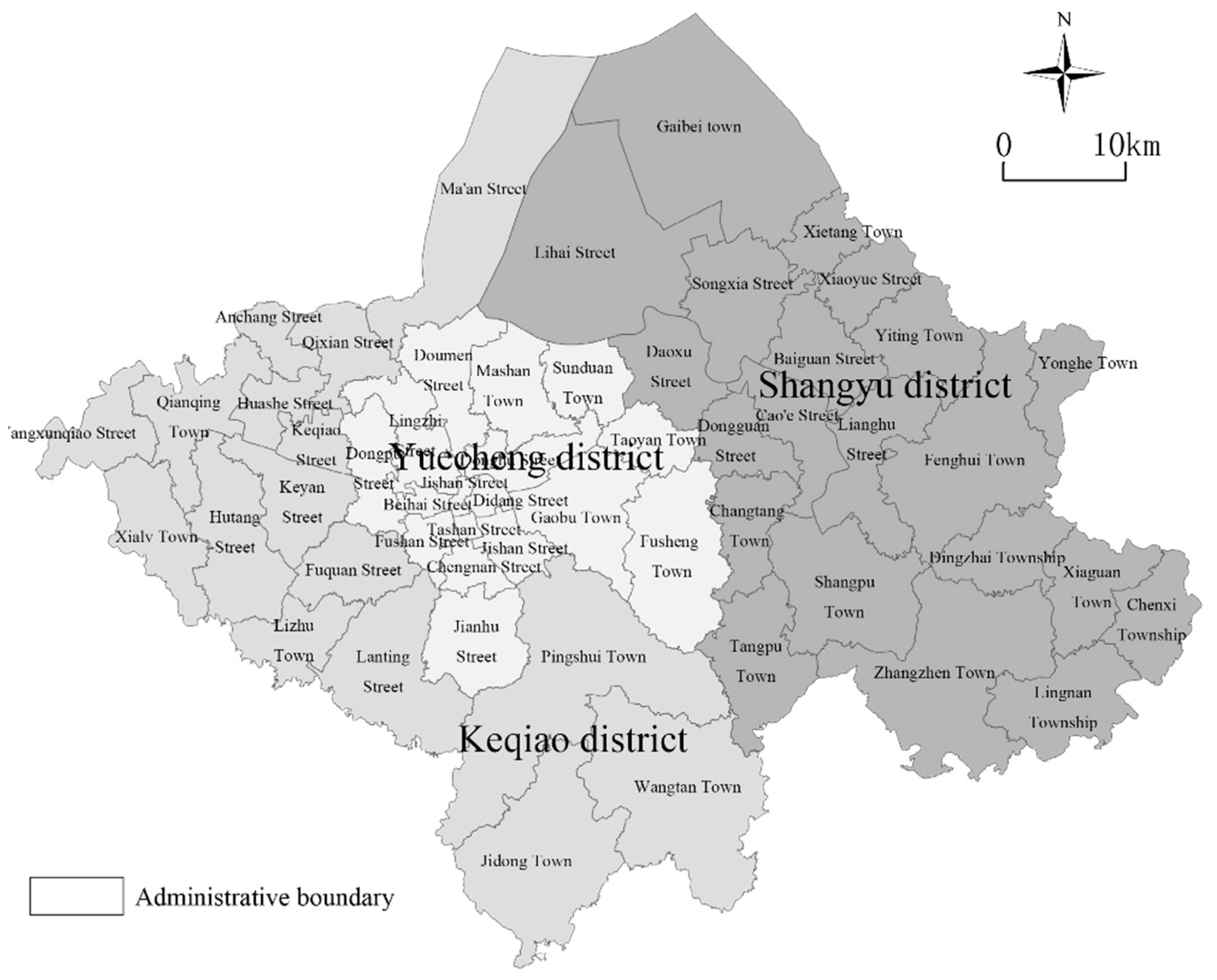
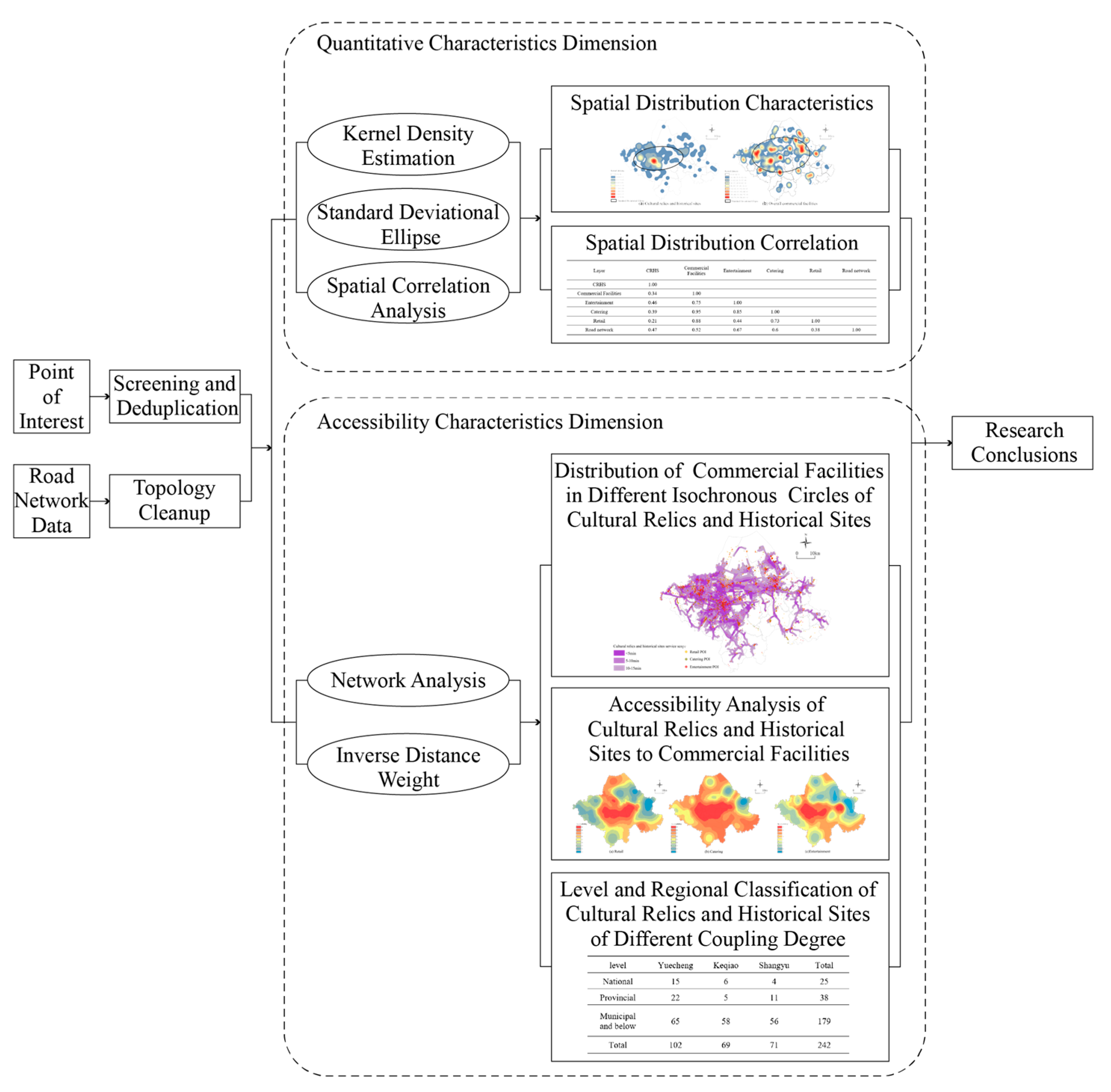
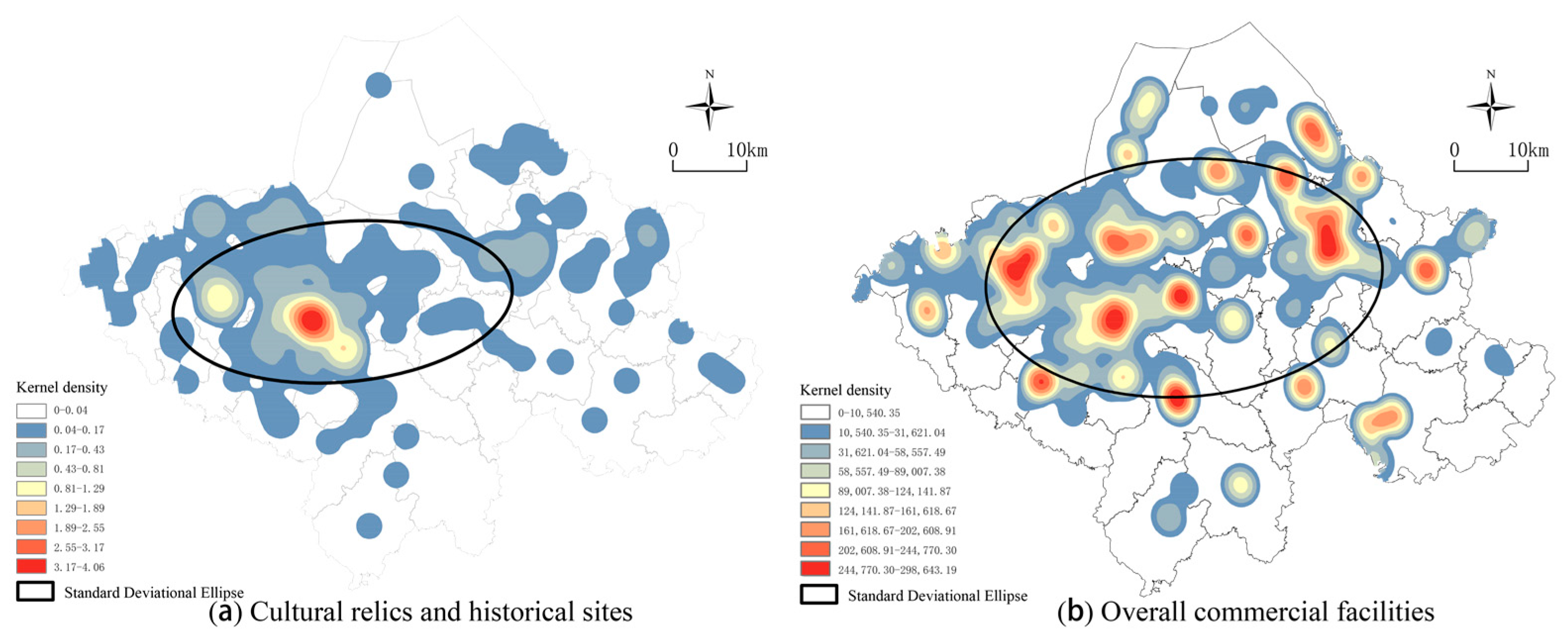

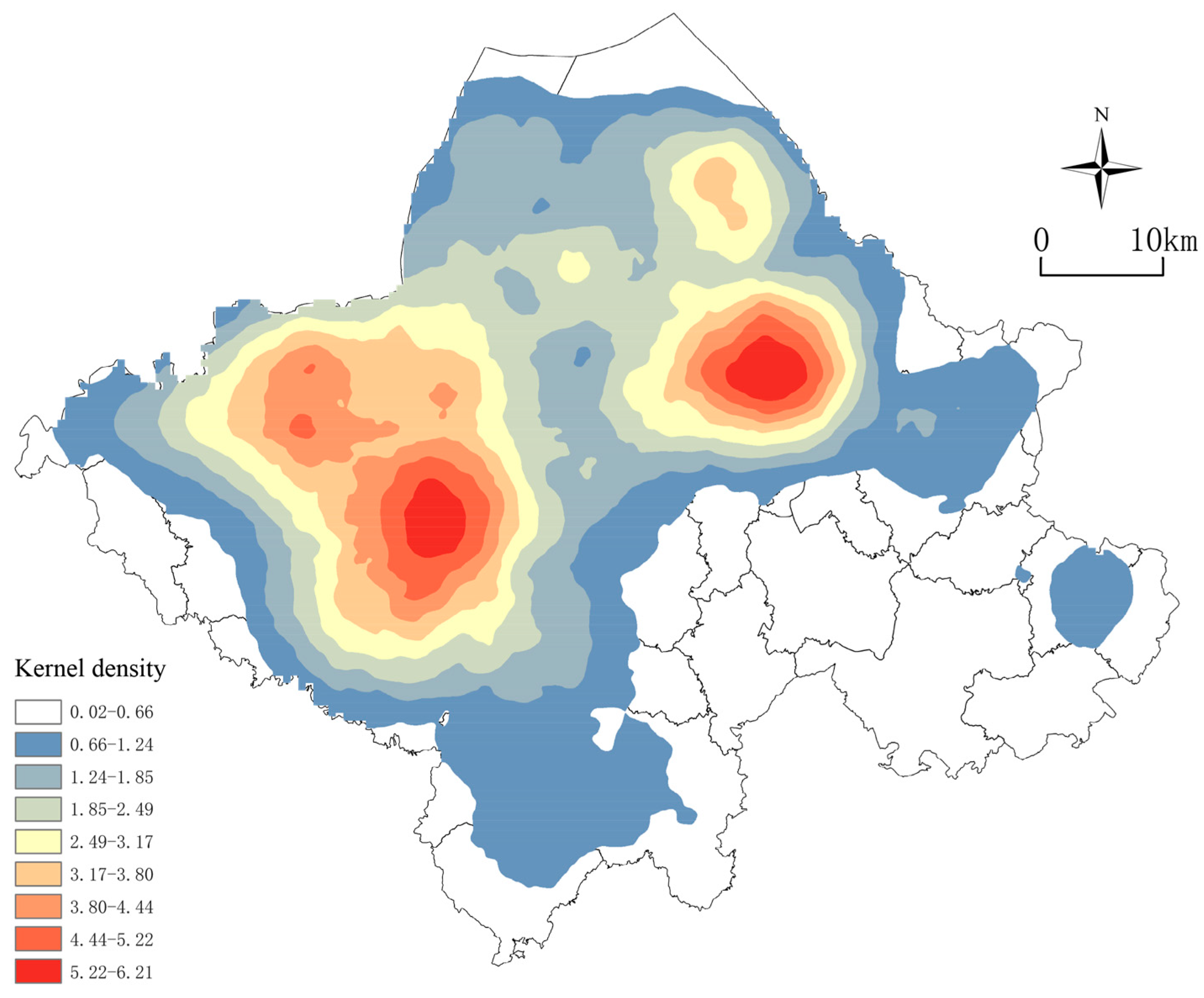
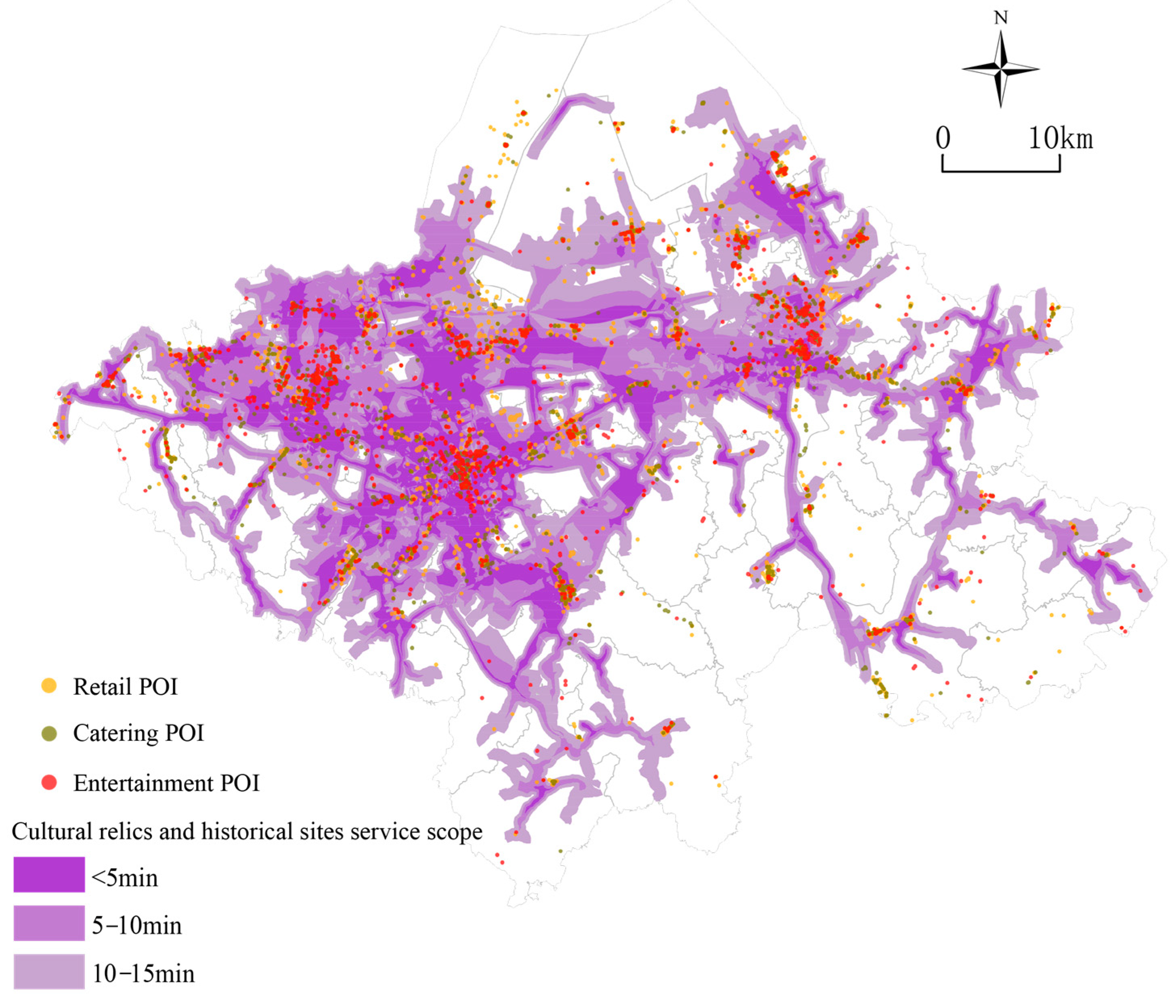
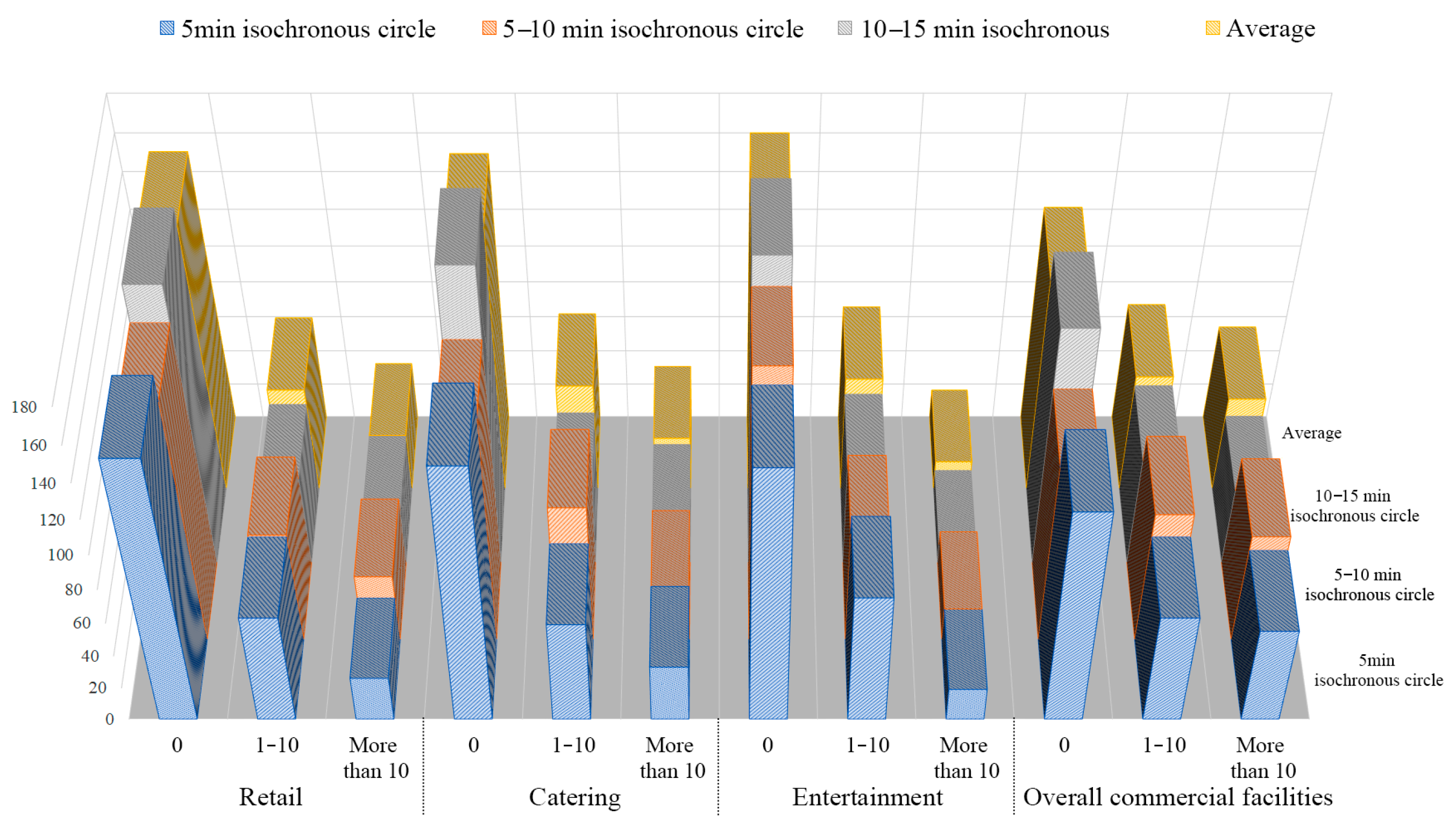

| Serial Number | Degree of Coupling | Travel Time |
|---|---|---|
| 1 | Better | <5 min |
| 2 | General | 5~10 min |
| 3 | Bad | 10~15 min |
| 4 | Poor | >15 min |
| Layer | CRHSs | Commercial Facilities | Entertainment | Catering | Retail | Road Network |
|---|---|---|---|---|---|---|
| CRHSs | 1.00 | |||||
| Commercial Facilities | 0.34 | 1.00 | ||||
| Entertainment | 0.46 | 0.75 | 1.00 | |||
| Catering | 0.39 | 0.95 | 0.85 | 1.00 | ||
| Retail | 0.21 | 0.88 | 0.44 | 0.73 | 1.00 | |
| Road network | 0.47 | 0.52 | 0.67 | 0.6 | 0.38 | 1.00 |
| Level | Yuecheng | Keqiao | Shangyu | Total |
|---|---|---|---|---|
| National | 15 | 6 | 4 | 25 |
| Provincial | 22 | 5 | 11 | 38 |
| Municipal and below | 65 | 58 | 56 | 179 |
| Total | 102 | 69 | 71 | 242 |
| District | CRHS Spot Count | Commercial Accessibility | Retail | Catering | Entertainment |
|---|---|---|---|---|---|
| Yuecheng | 102 | High-value region | Tashan Street, Beihai Street, Jishan Street, Chengnan Street, Didang Street, Jishan Street, Gaobu Town, Fusheng Town | Tashan Street, Fushan Street, Beihai Street, Jishan Street, Chengnan Street, Didang Street, Jishan Street, Lingzhi Street, Donghu Street, Doumen Street, Taoyan Town, Gaobu Town, Fusheng Town | Tashan Street, Fushan Street, Beihai Street, Jishan Street, Chengnan Street, Didang Street, Lingzhi Street, Jishan Street, Gaobu Town |
| Low-value region | - | - | - | ||
| Keqiao | 69 | High-value region | - | - | - |
| Low-value region | Xiale Town, Yangxunqiao Street, Hutang Street, Lizhu Town, Jidong Town | Xiale Town, | Xialu Town, Yangxunqiao Street, Hutang Street, Lizhu Town, Jidong Town, Qixian Street | ||
| Shangyu | 71 | High-value region | Dongguan Street, Changtang Town | Cao‘e Street, Dongguan Street, Changtang Town | Lianghu Street |
| Low-value region | Fenghui Town, Xietang Town, Lihai Street | Fenghui Town, Xietang Town | Baiguan Street, Fenghui Town, Dingzhai Township |
Publisher’s Note: MDPI stays neutral with regard to jurisdictional claims in published maps and institutional affiliations. |
© 2021 by the authors. Licensee MDPI, Basel, Switzerland. This article is an open access article distributed under the terms and conditions of the Creative Commons Attribution (CC BY) license (https://creativecommons.org/licenses/by/4.0/).
Share and Cite
Zhou, X.; Zhang, X.; Dai, Z.; Hermaputi, R.L.; Hua, C.; Li, Y. Spatial Layout and Coupling of Urban Cultural Relics: Analyzing Historical Sites and Commercial Facilities in District III of Shaoxing. Sustainability 2021, 13, 6877. https://doi.org/10.3390/su13126877
Zhou X, Zhang X, Dai Z, Hermaputi RL, Hua C, Li Y. Spatial Layout and Coupling of Urban Cultural Relics: Analyzing Historical Sites and Commercial Facilities in District III of Shaoxing. Sustainability. 2021; 13(12):6877. https://doi.org/10.3390/su13126877
Chicago/Turabian StyleZhou, Xuewen, Xiaoxia Zhang, Zhimei Dai, Roosmayri Lovina Hermaputi, Chen Hua, and Yonghua Li. 2021. "Spatial Layout and Coupling of Urban Cultural Relics: Analyzing Historical Sites and Commercial Facilities in District III of Shaoxing" Sustainability 13, no. 12: 6877. https://doi.org/10.3390/su13126877
APA StyleZhou, X., Zhang, X., Dai, Z., Hermaputi, R. L., Hua, C., & Li, Y. (2021). Spatial Layout and Coupling of Urban Cultural Relics: Analyzing Historical Sites and Commercial Facilities in District III of Shaoxing. Sustainability, 13(12), 6877. https://doi.org/10.3390/su13126877






